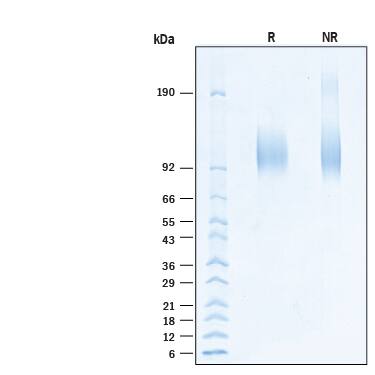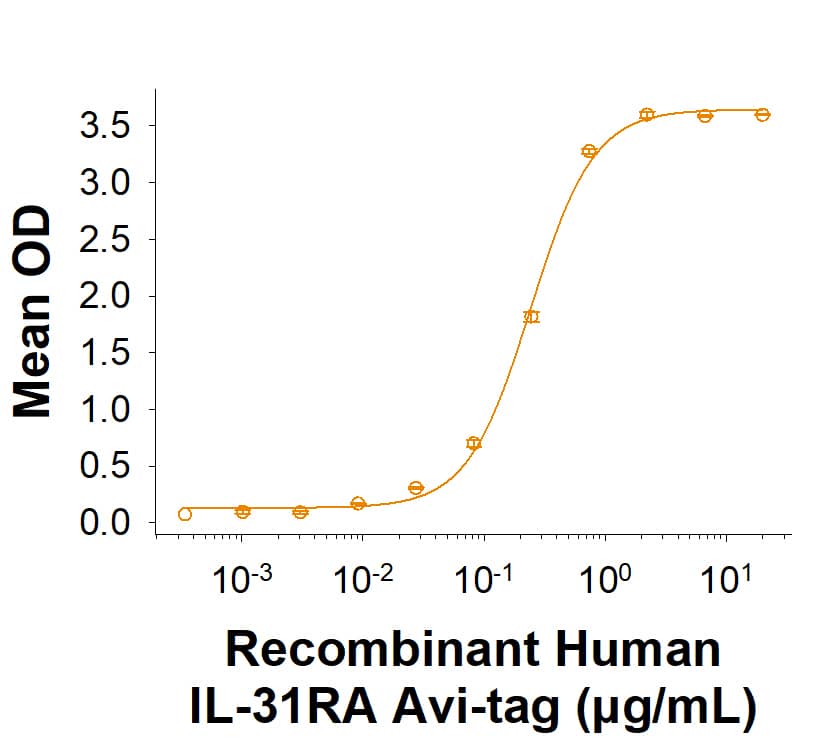Recombinant Human IL-31RA Avi-tag His-tag Protein, CF
R&D Systems, part of Bio-Techne | Catalog # AVI2769

Key Product Details
Source
Accession #
Structure / Form
Conjugate
Applications
Product Specifications
Source
| Human IL-31RA (Ala20-Ser516) Accession # AAS86444.1 |
Avi-tag | 6-His tag |
| N-terminus | C-terminus |
Purity
Endotoxin Level
N-terminal Sequence Analysis
Predicted Molecular Mass
SDS-PAGE
Activity
Recombinant Human IL-31RA Avi-tag His-tag (Catalog # AVI2769) binds Human Recombinant Human IL-31 (Catalog # 2824-IL/CF) with an ED50 of 0.100-1.20 μg/mL.
Scientific Data Images for Recombinant Human IL-31RA Avi-tag His-tag Protein, CF
Recombinant Human IL-31RA Avi-tag His-tag Protein Binding Activity.
Recombinant Human IL-31RA Avi-tag His-tag Protein (Catalog # AVI2769) binds Human Recombinant Human IL-31 (2824-IL/CF) with an ED50 of 0.100-1.20 μg/mL.Recombinant Human IL-31RA Avi-tag His-tag Protein SDS-PAGE.
2 μg/lane of Recombinant Human IL-31RA Avi-tag His-tag Protein (Catalog # AVI2769) was resolved with SDS-PAGE under reducing (R) and non-reducing (NR) conditions and visualized by Coomassie® Blue staining, showing bands at 90-105 kDa, under reducing conditions..Formulation, Preparation and Storage
AVI2769
| Formulation | Lyophilized from a 0.2 μm filtered solution in PBS with Trehalose. |
| Reconstitution | Reconstitute at 500 μg/mL in PBS. |
| Shipping | The product is shipped at ambient temperature. Upon receipt, store it immediately at the temperature recommended below. |
| Stability & Storage | Use a manual defrost freezer and avoid repeated freeze-thaw cycles.
|
Background: IL-31RA
The interleukin-31 receptor A subunit (IL-31 RA), also known as gp130-Like Monocyte Receptor (GLM-R or GPL), is a ~100 kDa type I transmembrane glycoprotein that is classified as being a type I cytokine receptor (1, 2). A heterodimeric complex of IL-31 RA and the oncostatin M receptor (OSM-R) functions as the signaling receptor for IL-31 (3). Both subunits are inducibly expressed throughout the myelomonocytic lineage and are upregulated by interferon-gamma and bacterial lipopolysaccharides (1-3). IL-31 RA is also expressed on keratinocytes, dorsal root ganglia neurons, and variably on lung epithelial cells (3-6). The 732 amino acid (aa) IL-31 RA contains a 19 aa signal sequence, a 500 aa extracellular domain (ECD), a 21 aa transmembrane domain and a 192 aa cytoplasmic domain. The ECD shares 60%, 58%, 73% and 70% aa identity with mouse, rat, canine and bovine IL-31 RA ECD, respectively. Human IL-31 receptors do not respond to mouse IL-31 (7). The ECD contains five fibronectin type III domains; the first two contain four conserved cysteine residues and a WSXWS motif common to type I cytokine receptors (2). Twelve alternately spliced human IL-31 RA isoforms are known and range in size from 356-745 amino acids. A long (745 aa) and a short (560 aa) transmembrane form are the predominant forms, and many cell lines express both forms (8). The long form, like the 732 aa form, signals by recruiting STAT3, 5 or 1, while the short form does not recruit STATs and inhibits IL-31 signaling. The ratio of these forms and their co-expression with OSM-R determines a cell's response to IL-31 (8). In both humans and transgenic mice, IL-31 from skin-homing Th2 cells may contribute to the pruritis (itching) associated with nonatopic dermatitis, especially in infected skin (3, 9, 10). Our Avi-tag Biotinylated human IL-31RA His-tag features biotinylation at a single site contained within the Avi-tag, a unique 15 amino acid peptide. Protein orientation will be uniform when bound to streptavidin-coated surface due to the precise control of biotinylation and the rest of the protein is unchanged so there is no interference in the protein's bioactivity.
References
- Ghilardi, N. et al. (2002) J. Biol. Chem. 277:16831.
- Diveu, C. et al. (2003) J. Biol. Chem. 278:49850.
- Dillon, S. R. et al. (2004) Nat. Immunol. 5:752.
- Chattopadhyay, S. et al. (2007) J. Biol. Chem. 282:3014.
- Perrigoue, J. G. et al. (2007) J. Exp. Med. 204:481.
- Bando, T. et al. (2006) Neuroscience 142:1263.
- Broxmeyer, H. E. et al. (2007) Exp. Hematol. 35:78.
- Diveu, C. et al. (2004) Eur. Cytokine. Netw. 15:291.
- Bilsborough, J. et al. (2006) J. Allergy Clin. Immunol. 117:418.
- Sonkoly, E. et al. (2006) J. Allergy Clin. Immunol. 117:411.
Long Name
Alternate Names
Gene Symbol
UniProt
Additional IL-31RA Products
Product Documents for Recombinant Human IL-31RA Avi-tag His-tag Protein, CF
Product Specific Notices for Recombinant Human IL-31RA Avi-tag His-tag Protein, CF
For research use only

